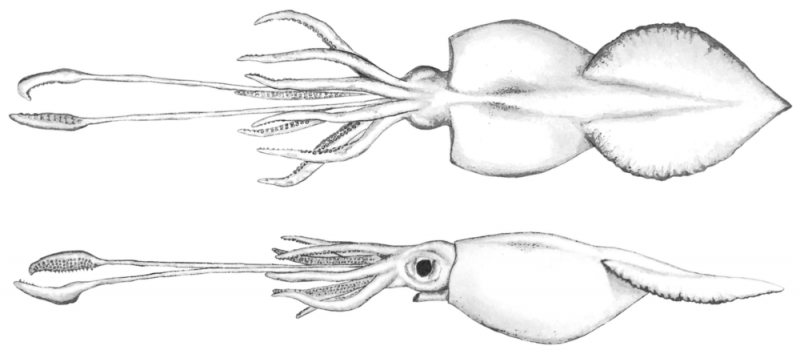The colossal squid (Mesonychoteuthis hamiltoni) is a large squid species belonging to the Cranchiidae family. Also known as the Antarctic cranch squid or giant squid, it's considered the largest squid species by mass. It is the sole member of its genus and inhabits the Antarctic region.
2 days ago : Colossal Squid Filmed for First Time in Deep Sea Natural Habitat
For the first time, a colossal squid was successfully filmed in its natural deep-sea habitat, resembling a glass sculpture. The footage provides unprecedented views of this elusive creature.
1924: Discovery of arm crowns in sperm whale stomach
In the winter of 1924–1925, two arm crowns of a colossal squid were found in the stomach of a sperm whale.
1925: Colossal squid formally described
In 1925, the colossal squid, species Mesonychoteuthis hamiltoni, was formally described by Guy Coburn Robson. The species belongs to the class Cephalopoda and family Cranchiidae.
1981: Immature female colossal squid caught in Ross Sea
In 1981, a Soviet Russian trawler caught a large squid in the Ross Sea, identified as an immature female of M. hamiltoni, with a total length of over 4 meters.
1981: Adult colossal squid specimen discovered
In 1981, an adult colossal squid specimen was discovered.
2003: Subadult female colossal squid found
In 2003, a complete specimen of a subadult female colossal squid was found near the surface, measuring 6 meters in total length.
2003: Second colossal squid specimen collected
In 2003, a second colossal squid specimen was collected.
2005: First living colossal squid captured
In 2005, the first full living colossal squid was captured at a depth of 1,625 meters off South Georgia Island. The squid's mantle was estimated at over 2.5 meters, and it weighed between 150 and 200 kg.
February 2007: Largest recorded colossal squid captured
In February 2007, a New Zealand fishing boat captured the largest recorded colossal squid, a female, in the Ross Sea off Antarctica. The squid was close to death and taken to New Zealand for study, estimated at 10 meters and 450 kg.
2007: Largest colossal squid captured
In 2007, the largest colossal squid, weighing 495 kilograms (1,091 lb), was captured and is now on display at the Museum of New Zealand Te Papa Tongarewa.
December 2008: Colossal squid specimen displayed at Museum of New Zealand
On 13 December 2008, the Museum of New Zealand Te Papa Tongarewa began displaying the captured colossal squid specimen.
2011: Colossal squid diet study begins
Between 2011 and 2014, a study revealed that Antarctic toothfish are a significant part of the colossal squid's diet, as evidenced by 71 toothfish out of 8,000 showing clear signs of colossal squid attacks.
2014: Colossal squid diet study ends
Between 2011 and 2014, a study revealed that Antarctic toothfish are a significant part of the colossal squid's diet, as evidenced by 71 toothfish out of 8,000 showing clear signs of colossal squid attacks.
2015: Colossal squid specimen records updated
As of 2015, only 12 complete colossal squid specimens had ever been recorded, with only half being full adults, the beak remnants being more commonly collected.
2018: Colossal squid exhibit temporarily closed
In 2018, the colossal squid exhibition at the Museum of New Zealand Te Papa Tongarewa was closed.
2019: Colossal squid exhibit reopened
In 2019, the colossal squid exhibition at the Museum of New Zealand Te Papa Tongarewa reopened after being closed since 2018.
2022: Expedition to film colossal squid in natural habitat
In 2022–23, scientists including KOLOSSAL attempted to film the colossal squid in its natural habitat for the first time, potentially filming a juvenile glass squid that requires DNA analysis to confirm if it is Galiteuthis glacialis or a new species.
March 2025: First filming of colossal squid in natural habitat
On 9 March 2025, the first definitive colossal squid was filmed in its natural environment, a juvenile measuring around 30 cm, by the Schmidt Ocean Institute's ROV SuBastian near the South Sandwich Islands.
Mentioned in this timeline
New Zealand is an island country located in the southwestern...
Squids are marine cephalopods with elongated bodies large eyes eight...
Trending

17 minutes ago Michelle McCool's Impending WWE Hall of Fame Induction Sparks Excitement and Debate

18 minutes ago Tiffany Stratton Eyes Olympic Debut, Addresses Charlotte Flair's Rookie Comment, and WrestleMania.

18 minutes ago Rory McCann Revealed as Baylan Skoll in Ahsoka at Star Wars Celebration.

18 minutes ago Jey Uso's Unexpected Rise, Gunther's Antagonism, and WrestleMania Night 1 Predictions Explored.

19 minutes ago Ludwig Kaiser Impresses WWE, Discusses Fan DMs, and Joins Show with Gable and Cargill.

1 hour ago Fuego Del Sol Unmasks at Spring Break, Leaves Boots, Appears to Retire
Popular
The Real ID Act of is a US federal law...

Bernard Bernie Sanders is a prominent American politician currently serving...

Michael Jordan also known as MJ is a celebrated American...

Cristiano Ronaldo nicknamed CR is a Portuguese professional footballer widely...

Marco Rubio is an American politician who served as a...

Donald John Trump is an American politician media personality and...
